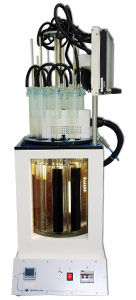
| OELCHECK test instrument: | Normalab TOST Classic |
| Sample quantity: | 300 ml or rather 360 ml |
| Unit: | hours |
| Test result: | oxidation stability of inhibited hydraulic fluids and lubricating oils for high pressure loads |
| Analysis for: | inhibited hydraulic fluids (hydraulic oils) and synthetic fluids with an HFDR (phosphoric acid ester), HEES (synthetic ester) and HEPG (polyglycol) base |
| Brief description: | 300 ml sample and 60 ml water (DIN EN ISO 4263-1) or rather 360 ml of pure sample (DIN EN ISO 4263-3) are aged at 95 °C in light-free conditions in an oxygen flow of 3 l/h and in the presence of a steel/copper catalyst. The neutralisation number is determined from the aliquots taken at regular intervals. Ageing is continued until the neutralisation number increases by 2.0 mg KOH/g. The test can also be ended after a fixed period (e.g. 1,000 hours) by agreement, irrespective of the increase in neutralisation number achieved. |
| Statement: | In large industrial facilities, pressure fluids must remain in use over several years. Gear oils in wind turbines should also not be changed long after 20,000 operating hours. Accordingly, oxidation stability plays a key role at high loads. The degree of oil oxidation or ageing which has already taken place is usually established by means of FT infrared spectroscopy. However, this does not allow reliable conclusions to be drawn regarding the tendency towards formation of acidic reaction products and deposits which may be produced as a result of long-term use and strain to the contacts. The TOST test simulates this long-term use and gives an indication of whether and when a significant increase in the products of ageing may be expected. |
| Underlying test standard: | DIN EN ISO 4263-1, DIN EN ISO 4263-3 |
| Comparable methods: | ASTM D943 (can only be performed by prior agreement) |